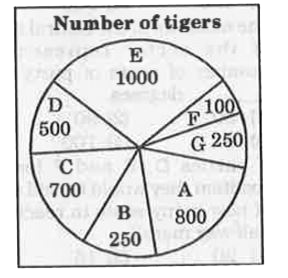a) All non-domesticated and non- cultivated biota found in natural habitat are termed______.
b) Wild life sanctuaries were established in India covering an area of sq. km
Video Solution
Text Solution
a) Wild life.
b) 1.6 lakh sq.km.
|
Updated on:21/07/2023
Related Playlists
Similar Practice Problems
- Question 1 - Select One
The pie chart shows the number of elephants in all the elephant wild life sanctuaries in the country. Study the diagram and answer the following questions.

If the average area occupied by each elephant in these sanctuaries is 50 sq km, then what is the total area (in 1000 sq km) of these sanctuaries?A200B150C100D300 - Question 1 - Select One
The pie chart shows the number of elephants in all the elephant wild life sanctuaries in the country. Study the diagram and answer the following questions.

If the average area occupied by each elephant in these sanctuaries is 50 sq km, then what is the total area (in 1000 sq km) of these sanctuaries?
(a)200
(b)150
(c)100
(d)300A200B150C100D300 - Question 1 - Select One
The pie chart shows the number of tigers in all the tiger wild life santuaries in the country. Study the diagram and answer the following questions.

If the average area occupied by each tiger in these santuaries is 90 sq. km., what is the total area (in 1000 sq. km.) of these santuaries?A412B508C324D544 - Question 1 - Select One
Read the source given below and answer the questions that follows: Total geographical area of India is 3.28 million sq km. Land use data, however, is available only for 93 per cent of the total geographical area because the land use reporting for most of the north-east states except Assam has not been done fully. Moreover, some areas of Jammu and Kashmir occupied by Pakistan and China have also not been surveyed. Forest area in the country is far lower than the desired 33 per cent of geographical area, as it was outlined in the National Forest Policy (1952). It was considered essential for maintenance of the ecological balance. The livelihood of millions of people who live on the fringes of these forests depends upon it. A part of the land is termed as waste land and land put to other non-agricultural uses. Waste land includes rocky, arid and desert areas and land put to other non-agricultural uses includes settlements, roads, railways, industry etc.
How much land use area is available of the total geographical area of India?A90%B97%C91%D93% - Question 1 - Select One
How many languages do we have in India ? The answer depends on how one counts it . The latest information that we have is from the Census of India held in 2001 . This census recorded more than 1500 distinct languages which people mentioned as their mother tongues . These languages were grouped together under some major languages . For example, languages like Bhojpuri, Magadhi, Bundelkhandi, Chhattisgarhi, Rajasthani, Bhili and many others were grouped together under Hindi . Even after this grouping, the Census found 114 major languages . Of these 22 languages are now included in the Eighth Schedule of the Indin Constitution and are therefore, called 'Scheduled Languages' . Others are called 'Non - Scheduled Languages . In terms of languages, India is perhaps the most diverse country in the world .
In terms of ______, India is perhaps the most diverse country in the world .ApopulationBlanguagesCforestsDreligions - Question 1 - Select One
Read the source given below and answer the questions that follows: Total geographical area of India is 3.28 million sq km. Land use data, however, is available only for 93 per cent of the total geographical area because the land use reporting for most of the north-east states except Assam has not been done fully. Moreover, some areas of Jammu and Kashmir occupied by Pakistan and China have also not been surveyed. Forest area in the country is far lower than the desired 33 per cent of geographical area, as it was outlined in the National Forest Policy (1952). It was considered essential for maintenance of the ecological balance. The livelihood of millions of people who live on the fringes of these forests depends upon it. A part of the land is termed as waste land and land put to other non-agricultural uses. Waste land includes rocky, arid and desert areas and land put to other non-agricultural uses includes settlements, roads, railways, industry etc.
What forest areas are considered essential for?Afor maintenance of the ecological balanceBfor economic developmentCto decrease landslides caused by rainfallDto control soil erosion only - Question 1 - Select One
Read the source given below and answer the questions that follows: Total geographical area of India is 3.28 million sq km. Land use data, however, is available only for 93 per cent of the total geographical area because the land use reporting for most of the north-east states except Assam has not been done fully. Moreover, some areas of Jammu and Kashmir occupied by Pakistan and China have also not been surveyed. Forest area in the country is far lower than the desired 33 per cent of geographical area, as it was outlined in the National Forest Policy (1952). It was considered essential for maintenance of the ecological balance. The livelihood of millions of people who live on the fringes of these forests depends upon it. A part of the land is termed as waste land and land put to other non-agricultural uses. Waste land includes rocky, arid and desert areas and land put to other non-agricultural uses includes settlements, roads, railways, industry etc.
Which area of Jammu and Kashmir not surveyed?Aareas occupied by local peopleBinternationally disputed areasCareas occupied by China and PakistanDall of the above - Question 1 - Select One
How many languages do we have in India ? The answer depends on how one counts it . The latest information that we have is from the Census of India held in 2001 . This census recorded more than 1500 distinct languages which people mentioned as their mother tongues . These languages were grouped together under some major languages . For example, languages like Bhojpuri, Magadhi, Bundelkhandi, Chhattisgarhi, Rajasthani, Bhili and many others were grouped together under Hindi . Even after this grouping, the Census found 114 major languages . Of these 22 languages are now included in the Eighth Schedule of the Indin Constitution and are therefore, called 'Scheduled Languages' . Others are called 'Non - Scheduled Languages . In terms of languages, India is perhaps the most diverse country in the world .
Bhojpuri, Magadhi, _____ , Rajasthani and many others were grouped under 'Hindi' .ABundelkhandiBUrduCKashmiriDBengali
Similar Questions
a) the methods adopted for disposal of harmful waste material are ______ , ______and_______.
b) Wild life sanctuaries were established in India in the pursuit of______.View SolutionThe pie chart shows the number of leopards in all the leopard wild life sanctuaries in the country. Study the diagram and answer the following question.

If the average area occupied by each leopard in these sanctuaries is 70 sq km, then what is the total area (in 1000 sq km) of these santuaries?View Solution

